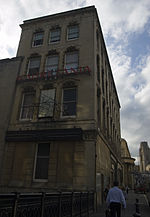St Mark's Church, Bristol

St Mark's Church is an ancient church on the north-east side of College Green, Bristol, England, built c. 1230. Better known to mediaeval and Tudor historians as the Gaunt's Chapel, it has also been known within Bristol since 1722 as the Lord Mayor's Chapel. It is one of only two churches in England privately owned and used for worship by a city corporation. The other is St Lawrence Jewry, London. It stands opposite St Augustine's Abbey (after 1542 Bristol Cathedral), founded by a member of the Berkeley family of nearby Berkeley Castle, from which it was originally separated by the Abbey's burial ground, now called College Green. It was built as the chapel to the adjacent Gaunt's Hospital, now demolished, founded in 1220. Except for the west front, the church has been enclosed by later adjacent buildings, although the tower is still visible. The church contains some fine late gothic features and a collection of continental stained glass. It is designated by Historic England as a grade I listed building.
Excerpt from the Wikipedia article St Mark's Church, Bristol (License: CC BY-SA 3.0, Authors, Images).St Mark's Church, Bristol
Broad Street, Nueva York Manhattan
Geographical coordinates (GPS) Address Nearby Places Show on map
Geographical coordinates (GPS)
| Latitude | Longitude |
|---|---|
| N 51.4517 ° | E -2.6015 ° |
Address
20 Broad Street
Broad Street 20
10004 Nueva York, Manhattan
Nueva York, Estados Unidos de América
Open on Google Maps










